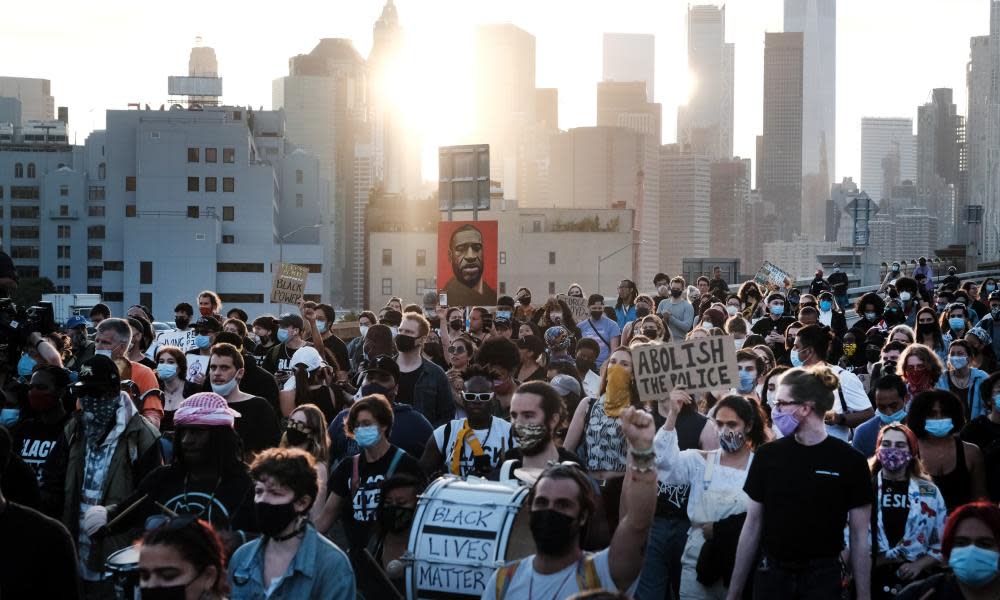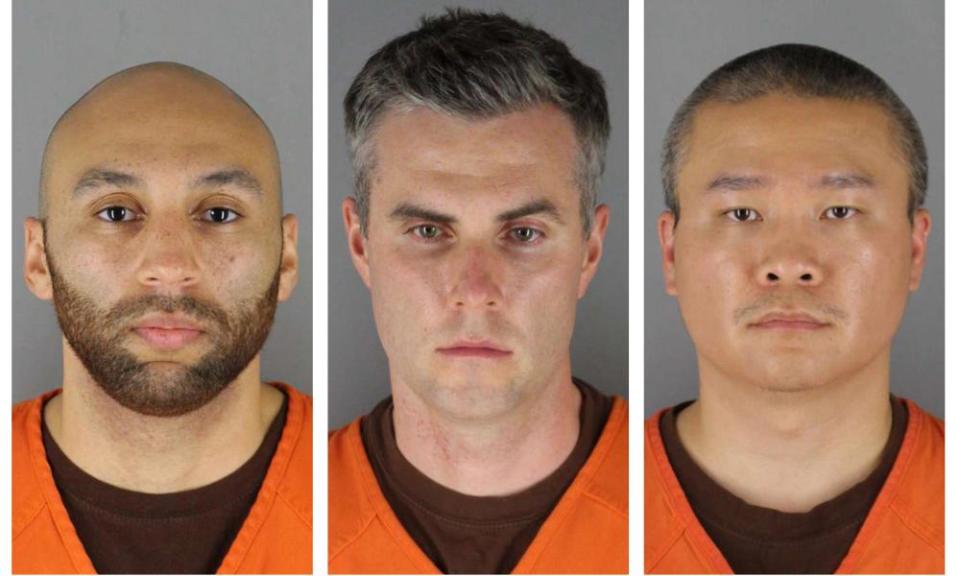Trial begins of three ex-police officers present at George Floyd murder

The bitter arctic blast, which had Minnesota temperatures below 0F , didn’t stop protesters from hosting a rally as the three lesser-known police officers accused of involvement in the killing of George Floyd faced their turn in the courtroom.
Related: ‘I have begged for justice’: key moments from the Derek Chauvin sentencing
A caravan of two dozen cars had occupied the length of the block outside the courthouse in the state capital, St Paul, last week, as jury selection began in the federal civil rights trial of Tou Thao, J Alexander Kueng and Thomas Lane.
Opening statements began on Monday, in the second trial of the closely watched process of legal accountability after the white former Minneapolis officer Derek Chauvin was convicted of murdering Floyd, a 46-year-old Black man, and admitted violating his civil rights in May 2020, sparking the largest racial reckoning in America’s recent history.
“The day that George Floyd was killed, in addition to Derek Chauvin as the officer that took George Floyd’s life, there were three other human beings that were there. They wore badges and guns, too. They were officers, too,” local activist Toshira Garraway told the bundled-up protesters standing in a tight circle outside their cars.
She added: “Not one of the four officers that was there had compassion and empathy enough to intervene.”

Chauvin, 45, was sentenced to 22.5 years in prison. In addition he pleaded guilty last December to federal civil rights violations, in one of the most momentous social justice cases of the century.
As the trial of the three subordinate officers got under way, a prosecutor told the jury they broke federal law by failing to stop Chauvin from killing Floyd, and were indifferent to the handcuffed man’s dying pleas.
Federal prosecutor Samantha Trepel, from the US Department of Justice’s civil rights division, said Thao, 35, Lane, 38, and Kueng, 27, had broken their oath with a callous indifference to Floyd. She recounted that video had captured how Kueng at times seemed more preoccupied with some gravel lodged in the tire of the nearby police car than the man pinned beneath him repeatedly saying: “I can’t breathe.”
The three have pleaded not guilty in both their civil rights case and their state case, which is due later this year and in which they are accused of aiding and abetting murder.
They are accused of depriving George Floyd of his right “to be free from a police officer’s deliberate indifference to his serious medical needs”, according to the charges.
Thao and Kueng are also accused of willfully failing to “intervene to stop Defendant Chauvin’s use of unreasonable force” when Floyd was unresponsive on the ground.
“Today is another milestone in the long, slow journey to justice for George Floyd,” Ben Crump, the civil rights lawyer who represented his relatives, said in a statement: “This trial will be another painful experience for the Floyd family, who must once more relive his grueling death in excruciating detail.”
A wide radius of security fences, tight police patrolling and road closures are in operation outside the federal courthouse amid concerns of mass protest.
“I don’t even count it as justice,” Steve Floyd, a community leader in Minneapolis and no relation to George, said. “I count it as accountability because I look at justice in another way: they [shouldn’t] have done that.”
Floyd’s murder ignited huge demonstrations across America and in many other countries, as the US Black Lives Matter movement revived and spread, although some of the protests against police brutality and entrenched racism more widely were often harshly curtailed by the police.

More than nine minutes of viral bystander video captured Floyd’s final moments, as Chauvin fatally knelt on Floyd’s neck while he was handcuffed and pinned on the street. Lane and Keung held the lower portion of Floyd’s prone body down while Thao kept back members of the public who were begging the officers to spare the man as he pleaded for mercy.
Related: ‘Deep systemic racism’: will Minneapolis’s police department ever change?
The video, captured by teenager Darnella Frazier, who was on her way to a corner store where Floyd had been accused of trying to use a counterfeit bill, was instrumental in Chauvin’s conviction. It will undoubtedly be used as evidence against the three officers in the federal case.
On Monday Trepel said: “For more than nine minutes, each of the three defendants made a conscious choice over and over again not to act. They chose not to intervene and stop Chauvin as he killed a man slowly in front of their eyes on a public street in broad daylight.”
Robert Bennett, a prominent civil rights lawyer in Minneapolis specializing in police brutality cases, said: “The defense is going to have to ask [the jury] not to believe their eyes. That’s the problem with this case because the elements are shown.”
Lawyers for the former officers variously called Floyd’s death a tragedy but not a crime by their client, an issue of improper training and a case of them being under the control of Chauvin, who was “calling the shots”.
Kueng, for example, was “a rookie officer” on his third ever shift and was let down by his seniors with “inadequate training”, his lawyer, Thomas Plunkett, said, adding that Kueng had hoped to improve the police department “from within”, having grown up in a racially diverse household.
While Lane is white, Kueng is Black and Thao is of Asian descent.
“The fact that two-thirds of the officers are officers of color reflects the fact that diversity alone cannot solve the problem of police violence,” Michelle Phelps, associate professor of sociology at the University of Minnesota, said.
Steve Floyd said he believed an officer’s race makes less of a difference when they all “become blue” and join what’s known as the blue wall of silence when law enforcement close ranks over the misconduct of their own.
The initial anodyne police press release after George Floyd was killed was headlined “Man Dies After Medical Incident During Police Interaction”.
But once Frazier’s mobile phone video surfaced, it became the heart of what Floyd’s family last spring called a “slam dunk” case against Chauvin, and a series of officers, from the then-police chief, Medaria Arradondo, on down the ranks, testified against the ex-cop in a noticeable, rare turn of events in favor of a Black victim of police violence.
But while some may think that the criminal and civil rights trials of these four former officers is a first step in holding police officers accountable, others are less optimistic.
“If you were to show the video – that I’ve never seen – of George Floyd being choked out for over nine minutes to a Black person living in the US under slavery, they would probably take a wild gamble that nothing has changed,” Toussaint Morrison, a Minneapolis activist, said. “So locking those boys up doesn’t mean justice to me.”
There was a strong movement after Floyd was murdered to replace the Minneapolis police department with a public safety unit.
Voters ultimately rejected those proposals, but demands for equity and law enforcement reform persist.
“You can’t un-know or unsee the extremes of public violence and modern-day attempts to lynch people of color in Minnesota – and that goes for Black and Native folks and folks of color,” Morrison said.

 Yahoo Movies
Yahoo Movies 
